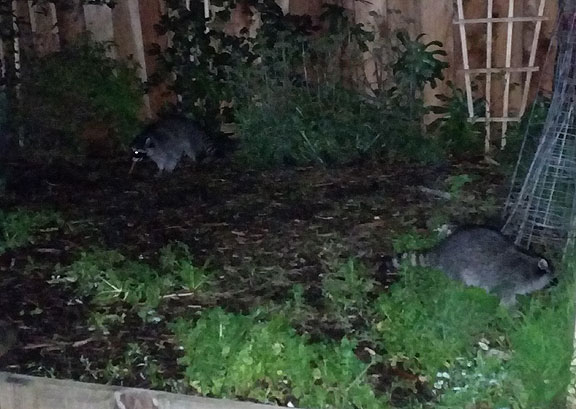
These raccoons had their way in our backyard during our annual Posada on December 17… fearless critters!
There haven’t been any recent attempts that I’m aware of, but I know it’s true. We had some very rambunctious raccoons rolling around our backyard during the Posada on December 17,and they were utterly unafraid of the dozen humans standing a few steps away. But they made no move to attack.
It’s actually a standing joke among my friends. I write and talk a lot about ecology and transforming urban life to harmonize with natural systems. I’m very concerned about climate change and probably pay more attention to the cascading bad news than most people I know. And yet I hate camping (dishwashing in the woods as far as I’m concerned). People and their pets (especially dogs) drive me crazy—I hate how people anthropomorphize their animals and then treat them like children. I eat meat with enthusiasm, and find proponents of animal rights and/or veganism too often some of the most pedantic, moralistic, and generally unhappy and unpleasant people I’ve met (with some exceptions, happily).
In spite of being an inveterate urbanite who feels safer sitting in a parking lot than next to a babbling brook buzzing with insects and birds, I think about nature and ecology a lot. Lately I’ve been reading a lot too, and I’ll be quoting from five different books during this post. It’s been a bit like taking a quick class in urban ecology, though the books covered here aren’t quite that focused. From the most philosophically minded, Imagining Extinction: The Cultural Meanings of Endangered Species (by Ursula K. Heise, University of Chicago Press: 2016), to the most down-to-city-earth Unseen City: The Majesty of Pigeons, The Discreet Charm of Snails & Other Wonders of the Urban Wilderness (by Nathanael Johnson, Rodale Press, New York: 2016), the books here help us take a big step back from the panicky urgency that arose in response to the election of Trump.
I understand that the Trump regime will be a wrecking ball to most of the environmental gains of the past half century. Moreover, developing a nuanced understanding of a healthy relationship between human life and nature will not only not gain traction, but whatever has been gained will likely be reversed now. But going into panic mode and rushing about without a strategy seems like a bad idea to me.
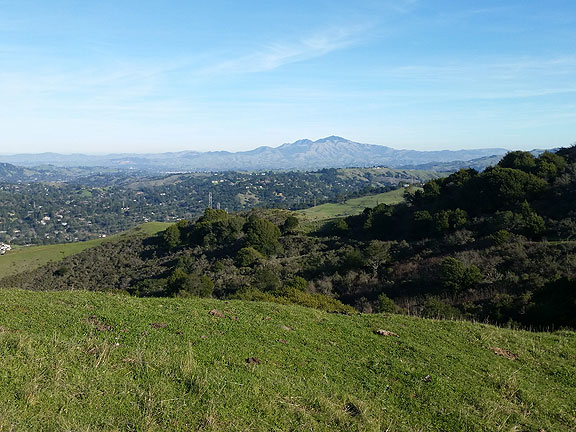
The view of Mt. Diablo from the top of the Sibley Volcano just southeast of the Caldecott Tunnel in the east bay hills.
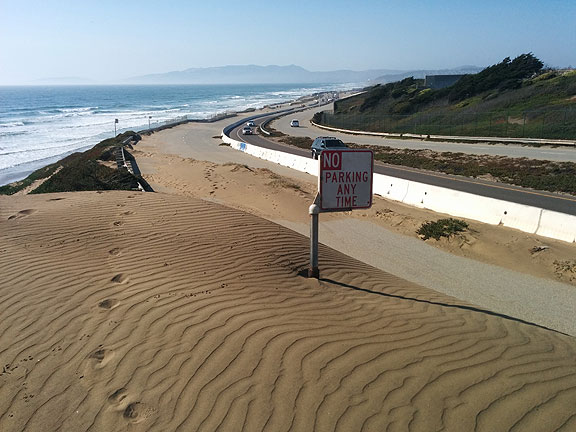
Nature having its way with infrastructure!
I decided it’s a good time to think deeply about where we are and where we might go. The fraught politics of inequality built on centuries of racism, sexism and general fear and loathing of “others” is not something that doubling down on the smug self-satisfied rhetoric of coastal know-it-alls is going to adequately address. It’s hard to believe that anyone in their right mind could vote for an obvious liar and huckster like Trump. But when you pause for a moment it’s easy to see that Trump is not such a departure really, and that Americans have voted for frauds and charlatans as president almost as often as not. Something primal happens to voters, apparently, and given the chance to support a venal, hateful demagogue who promises the moon an awful lot of people say “give me the moon then,” realism be damned.
I am thankful for the time I had to read these smart books, which in addition to the two mentioned, also include Are We Smart Enough to Know How Smart Animals Are? (by Frans de Waal, W.W. Norton & Company, New York: 2016), Citizen Scientist: Searching for Heroes and Hope in an Age of Extinction (by Mary Ellen Hannibal, The Experiment LLC, New York: 2016), and Satellites in the High Country (by Jason Mark, Island Press: Washington DC 2015). An earlier book I read kept looping itself back into the conversation these books had in my head, which was Feral by George Monbiot that I briefly mentioned in an earlier post.
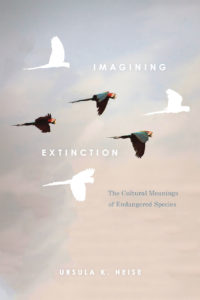
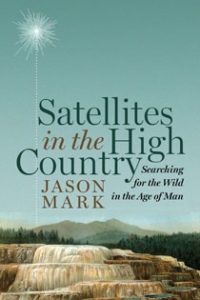
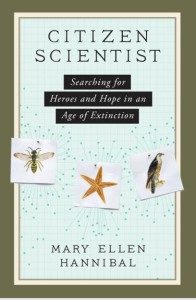
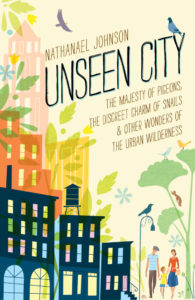
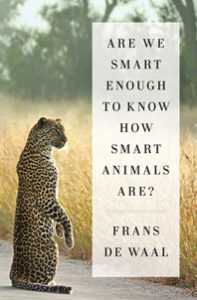 Monbiot argued in his book that we should restore apex predators into our environment to re-establish a sense of awe, fear, and excitement that we are lacking in modern life (imagine having to consider encountering a bear on the way to the corner store!). His book seeks to break with the dogmas of mainstream environmentalism, and to a great extent that is what is refreshing about all of these books too. Each of the writers in their own way is trying to rethink, reimagine, and propose a new approach to what has become an impossible cul-de-sac of environmental degradation, climate chaos, and rapidly accelerating extinction. All of the writers here have gone beyond the paradigms that beset radical environmental thinking only a generation ago, wherein humans were still largely outside of and the opposite of “nature.” All of them, in various ways, are trying to articulate new approaches to some kind of reconciliation, to finding a way that humans as natural beings can find an appropriate set of philosophical assumptions to shape new behaviors that in turn work with the logic of nature instead of being implacably against it.
Monbiot argued in his book that we should restore apex predators into our environment to re-establish a sense of awe, fear, and excitement that we are lacking in modern life (imagine having to consider encountering a bear on the way to the corner store!). His book seeks to break with the dogmas of mainstream environmentalism, and to a great extent that is what is refreshing about all of these books too. Each of the writers in their own way is trying to rethink, reimagine, and propose a new approach to what has become an impossible cul-de-sac of environmental degradation, climate chaos, and rapidly accelerating extinction. All of the writers here have gone beyond the paradigms that beset radical environmental thinking only a generation ago, wherein humans were still largely outside of and the opposite of “nature.” All of them, in various ways, are trying to articulate new approaches to some kind of reconciliation, to finding a way that humans as natural beings can find an appropriate set of philosophical assumptions to shape new behaviors that in turn work with the logic of nature instead of being implacably against it.
The sharpest analysis comes from Ursula Heise, who takes the time to unravel the philosophical contradictions that riddle the field with landmines. She’s very good at asking difficult questions as when she poses these:
What stories do we tell about the relationship between colonialism, the oppression of humans, and the endangerment of animals and plants? How do these stories respond to the theoretical questions and ethical dilemmas that arise in the confrontation with the immiseration of humans and nonhumans? (p. 166) What are the connections and disjunctures between violence against disenfranchised communities and against endangered species? Whose risk perceptions determine conservation efforts, and what institutional shapes do these efforts take? Who protects, on what authority, and who is assumed to be in need of protection? (p. 194)
Her book breaks interesting ground, examining the role of archives and databases as cultural mechanisms for establishing meaning as important as science fiction, ethnography, and theories of justice. All of these are woven together in the book, producing some refreshing new ways of thinking about our predicament.
Both the vanishing of species and the emergence of new ones, then, are entangled in the making and unmaking of community identities, in modernization and the resistance to it. (p. 50) The choice of what kind of biodiversity is valued more than other kinds in each regime ultimately obeys cultural orientations that are rooted in different perspectives on modernization understood as a grand-scale process of domestication. (p. 132) If excessive and sometimes unintended domestication, then, is what puts animals and the natural world in peril from the environmentalist perspective, it is incomplete or misguided domestication that leads to the abuse of biological others in the animal welfare view. (p. 133)
Given my own antipathy for animals and especially wild ones, I found this way of framing it weirdly useful. I’d never felt at ease with animal welfare advocates with their micro-focus on individual animal lives (which is easily turned into an anthropomorphizing of pets). “Excessive domestication” resonates with my sense of what’s wrong with modern life, but recognizing this in her context was to affirm that cultural orientations toward modernization are relatively determinant of attitudes towards the wild. My allergies to dogs and cats and lack of direct involvement with other animals has kept me relatively blind to the complexity of animal psychology and its attendant consequences. Heise touches on this in a footnote about how rapidly we are re-evaluating our sense of animal intelligence:
This reorientation is no doubt in part due to rapidly advancing scientific research on the cognitive abilities, emotions, communication systems, tool uses, complex social structures, and culturally transmitted forms of custom and knowledge among a variety of animal species, from ants and cephalopods to birds and primates. But it is also, more broadly, related to shifting cultural conceptions of nature. (p. 143 footnote #12 in reference to Donna Haraway)
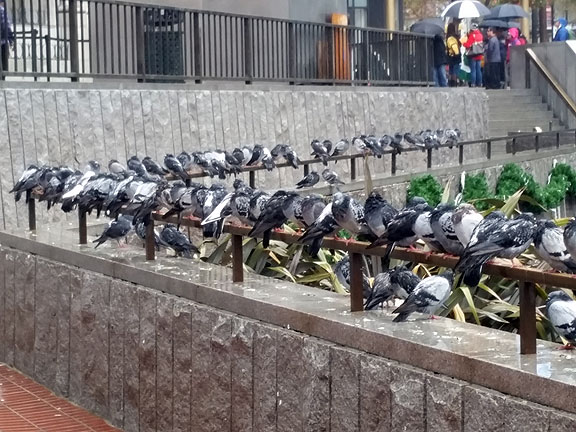
Gathering forces!

A West Indian Woodpecker, seen not far from the Bay of Pigs!
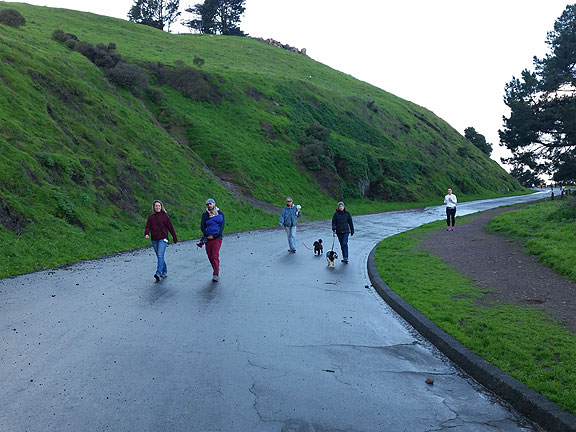
Pets and their owners dominate the Bernal Heights ring road…
But I learned a lot from reading Frans de Waal’s best-selling book on animal intelligence, which echoed another book I used when working on Nowtopia almost a decade ago, Jeremy Narby’s Intelligence in Nature. De Waal goes a lot further since he is a longtime proponent and lead scientist in the field of what he calls “evolutionary cognition.” It begins with ethology, or the systematic observation of animal behavior. I loved learning this word which had somehow escaped me until now. Another book I leaned on heavily when researching Nowtopia was The Body of the Artisan by Pamela H. Smith, which presents a great history of how artisans in the late middle ages/early Renaissance developed a new understanding of “natural philosophy” based on “reading the book of nature.” 500 years ago it was obvious that close observation of natural processes was a great teacher—even if such an approach directly contradicted the dogmas of the Church at the time. We have our own dogmas of course, far more than we care to admit, and one that I unconsciously accepted for a long time is that humans are unique in our capacity for consciousness, which gives us a type of intelligence qualitatively different than other species. Turns out this is not true, as Frans de Waal describes:
Anything related to consciousness has been hard to accept in other species. But this reluctance is problematic: not because we know so much more about consciousness, but because we have growing evidence in other species for episodic memory, future planning, and delayed gratification. Either we abandon the idea that these capacities require consciousness, or we accept the possibility that animals may have it too. (p. 229) …there is sound evidence that mental processes associated with consciousness in humans, such as how we relate to the past and future, occur in other species as well. Strictly speaking, this doesn’t prove consciousness, but science is increasingly favoring continuity over discontinuity. This is certainly true for comparisons between humans and other primates, but extends to other mammals and birds, especially since bird brains turn out to resemble those of mammals more than previously thought. All vertebrate brains are homologous. (p. 234)
If the continuity of intelligence among all living beings is a better way to understand the world, we can no longer pretend there are no ethical problems with how humans are imposing themselves on the planet—on its inhabitants, its basic systems, and even the atmosphere and the oceans at this point. We can blame capitalism for its voracious logic of growth and destruction, but we can’t escape the ethical responsibilities we’re shirking towards the rest of life while this human-made system runs roughshod over the world.
Mary Ellen Hannibal’s book Citizen Scientist goes much further than its title would suggest, including an excellent history of the San Francisco-based Academy of Science, and a great deal of rumination on earlier projects that featured non-scientists doing science, notably the Ed Ricketts and John Steinbeck trip to the Sea of Cortez in the 1940s. Much of our contemporary view of nature and wild life is rooted in 19th century sensibilities, that are in turn heavily influenced by Charles Darwin and his contemporaries.
Tracing the influences on Ricketts back to his time at the University of Chicago, she describes a relatively unheralded zoologist there Warder Clyde Allee and his “organismic-community concept” which emphasizes the group over the individual.
A practicing Quaker, [Warder Clyde] Allee sought to integrate ethics and science and argued that animals benefit from living in cooperation. He asserted that “the two great natural principles of struggle for existence and of cooperation are not wholly in opposition, but… each may have reacted upon the other in determining the trend of animal evolution.” Allee expressly looked for biological grounds upon which to argue the benefits and naturalness of cooperative human societies, posing the idea in counterbalance to the every-organism-for-itself way of looking at Darwin’s definition of natural selection. (p. 295)
Ideology is never far removed from science, in spite of all the claims over the decades of objectivity and clear-headedness. Ethics are at the heart of science, or should be, as they also ought to be at the heart of most social decision-making. Up to the present most of our ruminations on ethics have limited themselves to interactions among humans, but Heise, Mark, and Hannibal all bring forward a new kind of ethical framework to consider earthly life going forward.
Considering biodiversity conservation in [the] context of social justice opens up … different … issues: not the question of whether we should aim to conserve the welfare of individual animals or that of species but how we can articulate human rights and human aspirations to a good life together with the claims of nonhuman species on our moral consideration. (Heise, p. 165)
The idea of multispecies justice, I have suggested, might prove a useful tool in thinking about biodiversity and conservation: it puts questions of justice for both humans and nonhumans front and center, even as it emphasizes that justice itself has to be imagined at the intersection of different cultural perspectives that may diverge in their concept of what is just. (Heise, p. 202)
There are two main ethical questions that humans of compassion must grapple with. The first—the one that has consumed moral philosophers for most of history—is how to treat other people. What are the requirements of justice and equality and liberty? The second—the one that Leopold articulated so clearly—is how to treat other species. What are the requirements of ecological justice and fairness? (Mark, p. 82)
…plants and animals that have not yet reached the end, for which death has yet the possibility of being a generational and not a species-terminating event. If we will but observe them, aggregate their instances and their movements, accommodate and support them, see ourselves as part of and not lords over their world. (Hannibal, p. 390)
Perhaps the biggest and most important task before us is to recalibrate our sense of place on earth. Jason Mark’s book both rejects the notion of pristine nature and urgently embraces the “wild” as the category of life we must defend and extend. Hannibal quotes in her book the famous biologist E.O. Wilson’s call for reserving 50 percent of the planet for nature without further human intervention.
It doesn’t work of course, just to save any old half for nature. .. Wilson advises that we save the mega linkages first—for example, what’s known as the spine of the continent, which runs the length of North America from the Yukon to Mexico. Thus plants and animals will be able to move as the climate changes, and they will be able to mix with others of their own kind of different populations. This is not nature cordoned off away from humans. Wilson envisions a vast interconnection of wilderness areas interpenetrating with human development… By not literally quantifying how much aquatic and terrestrial real estate is necessary to meet the quantified needs of healthy biodiversity, we have let far too much slip through nature’s hands and into the roiling maw of development. (Hannibal, p. 354)
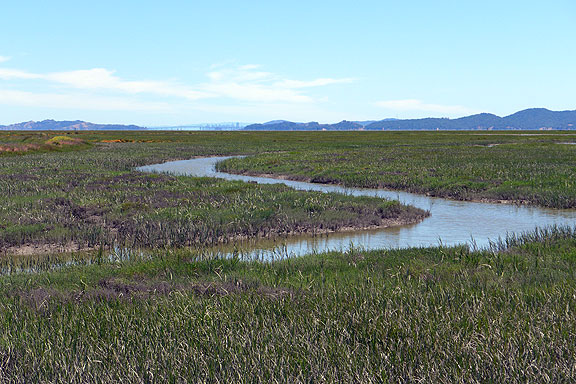
Restored wetlands on north rim of Bay, San Francisco visible in far distance.
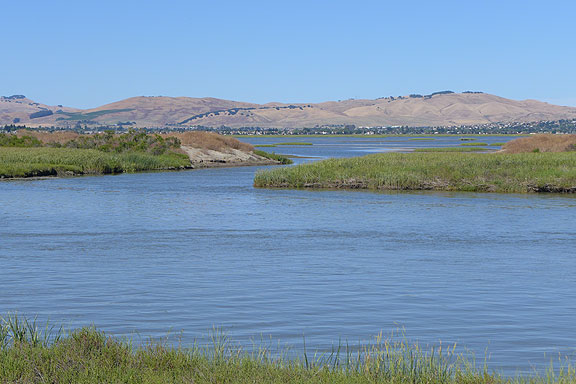
More recently restored wetlands near Vallejo.
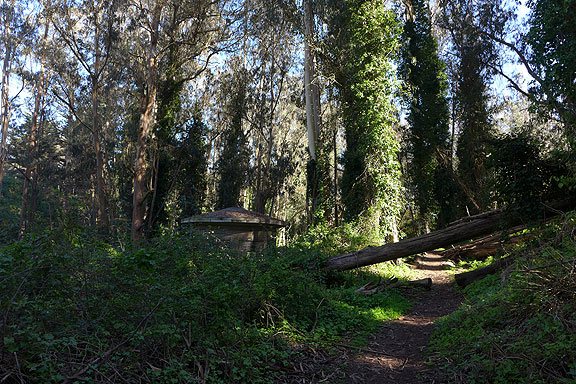
Senascent Eucalyptus forest near Laguna Honda draped in German ivy.

Glen Canyon, a wild spot in the heart of the City.
Rewilding is a multifaceted concept that allows for more human creativity than you might think at first glance.
As in the case of de-extinction, rewilding may well turn out to be most useful when it is not mainly envisioned as a means of returning to the ecological past but as a tool in the creation of functional ecosystems for the future. (Heise, p. 212)
Rewilding flips conservation from a defensive, rear-guard action into a forward-looking act of imagination determined to create more abundance. Rewilding affirms that we don’t always have to play the role of destroyer. Our interventions with wild nature can be virtuous, too. (Mark, p. 186-187)
In the wild we can have a place where evolution continues unimpeded (if not uninfluenced), where life adapts on its own, even if those adaptations are just responses to human actions. When you think of it that way, Thoreau’s declaration that “in wildness is the preservation of the world” takes on an even deeper and more urgent meaning. Wildness doesn’t merely preserve the world—wildness perpetuates it. (Mark, p. 126)
… I am suggesting that the values, cultural perceptions, emotions, and traditions that inflect our perceptions and interactions with nonhuman species always have to be an explicit part of conversations about conservation, and that thinking about the construction of new, functional multispecies habitats may be more productive and democratic goal to invest our energies in than the attempt to recreate the habitats of the past. (Heise, p. 236)
We tend to think of nature and civilization as being irreconcilably opposed: Civilization’s gain is nature’s loss. But in fact, cities have become prime habitat for speciation, hybridization, and in short, rebirth. Certainly, civilization has upended the status quo in nature, but it is also proving to be a vehicle for a natural renaissance. (Johnson, p. 198)
Our writers aren’t all always on the same page by any means. That’s ok. We face unprecedented confusion and world-spanning challenges. Though I think we can see emergent sensibilities that can help shape a new way for human society to organize itself going forward, the impediments of the world we’re in remain as daunting as ever. Ursula Heise, for example, thinks relying on the critique of capitalism to frame an adequate response to the crisis of extinction, biodiversity, and climate chaos is to duck the question:
…even if a collective will to develop an alternative economic regime were to emerge in some of the planet’s dominant nations, the transition to such a regime would almost certainly take decades (more likely, a century or more)—too late to affect the current climate crisis decisively. [The] assumption that overcoming capitalism is a prerequisite for addressing the climate crisis, in practice, simply denies the possibility of coming to terms with it. (p. 223)
Jason Mark concludes his inspiring book with a bit of a thud when he admonishes his readers that we’ll have to “domesticate ourselves further.”
To share space with wild plants and animals will require that we shrink humanity’s footprint… Those of us lucky enough to live in the wealthy nations will have to do much better at sharing the planet’s riches with the billions who remain energy-poor and calorie-hungry. In short, we’ll need to rein in our appetites and restrain our baser instincts. (p. 230)
Nathanael Johnson, after a fun ride through close-up urban experiences with pigeons, crows, gingko trees, squirrels, ants, and snails, harkens back to the romance of the first peoples in North America and their relationship to the land:
If we come to love nature not only when it is rare and beautiful, but also when it is commonplace and even annoying, I believe it will heal the great wound of our species: our self-imposed isolation from the rest of life, our loneliness for nature. We might remember that we are no different from our surroundings, that the trees and birds are as much our neighbors as other humans. We might remember that before the land belonged to us, we belonged to it. We could belong again. (p. 201)
Mary Ellen Hannibal writes beautifully about her father’s slow passing during the preparation of the book, providing a very personal experience of death to frame the abstract discussion of extinction and preservation that her book is about. When he dies near the end of her narrative, it gives her a chance to ruminate on systemic death as opposed to individual death, which is finally what we’re up against now.
What about the imminent loss of not only thousands of individual plants and animals but also their future kith and kin—the moment still teetered between past and possibility; was not just death at the door but with it the end of birth? In the hero’s journey, one life ends to nourish those that will follow. But if this story no longer applies, because we are consuming and not sustaining nature, what is the meaning of individual life? (Hannibal, p. 390)
Four decades ago I went off to college with a burning desire to understand ethics. I suppose if it had been centuries earlier I might have opted for theological studies (though celibacy was NEVER an option!!). In some ways my time on the earth has been bookended by the early concerns I had for what would constitute an ethical society, and today’s necessary broadening to posit questions about what constitutes a new kind of multispecies ethics.
The Human Age has thrown us into a terra incognita that we are having to learn to navigate on the fly. Increasingly, we don’t just conserve ecosystems—we curate them. In the process we are forced to make life-and-death decisions about what we hope to protect and preserve, what we’re willing to stave off and suppress. (Mark, p. 113)
Ursula Heise puts this new sensibility—so difficult to expect a broad population to fully embrace it any time soon—at the heart of her conclusion:
Multispecies ethnography… focuses on some of these relations to develop new descriptions of human societies. Such ecological connectedness, especially for twenty-first-century citizens shaped by material and sociocultural structures that tend to make their own dependence on ecological networks invisible, may not be immediately perceptible or experienceable any more than the social embeddedness into class or nation; indeed, probably less so because there are fewer historical precedents for conceiving of “species” as a relevant social category… On the contrary, eco-cosmopolitanism as I conceive it is shaped by an awareness that very little commonality can be taken for granted and that speaking about the human species, humanity, humanness, or the Anthropocene requires a patient and meticulous process of assembly—in its most craftsmanlike and technological connotations…. Decisions about biodiversity are in the end questions about value, about cultural frameworks of thought, and about historical traditions of social practice… The future of endangered species and of biodiversity conservation is not, in the end, just a matter of science, but also and mainly one of histories, cultures, and values.
I would say the same about humans and life in general: it’s mainly a matter of histories, cultures, and values. Whether or not we know our histories, see our cultures as embedded in a wide range of social and ethical possibilities, and what we choose to do with that knowledge—these are the gnarly challenges of the present. The immediate prospect of violent reactionaries running the government only complicates the process—we face these deeper challenges at this point in history, whomever is officially “in charge.”
I might still believe nature is trying to kill me, but I’m definitely NOT trying to kill it! I like the idea of withdrawing from large swaths of land and re-engineering our lives in urban areas to work harmoniously with the logic of nature, to the greatest extent possible. This seems like work worth doing, with the ultimate goal of reducing how hard we work and how wasteful we are with this one-and-only home we have. We could all live a wonderful life, materially satisfied, and culturally enriched, if that were the goal and the guarantee of our shared lives. What else are we here for?
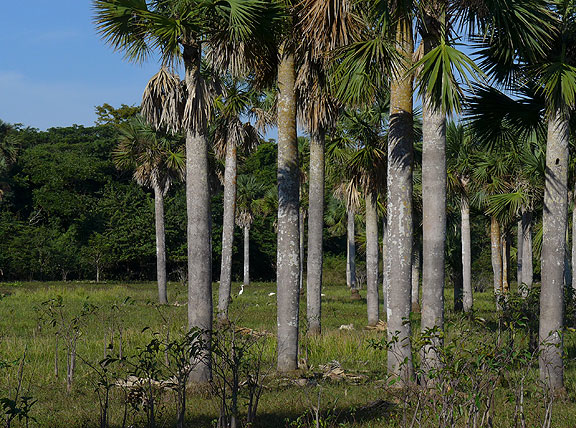
Flourishing bird life in the protected wetlands to the east of the Bay of Pigs.
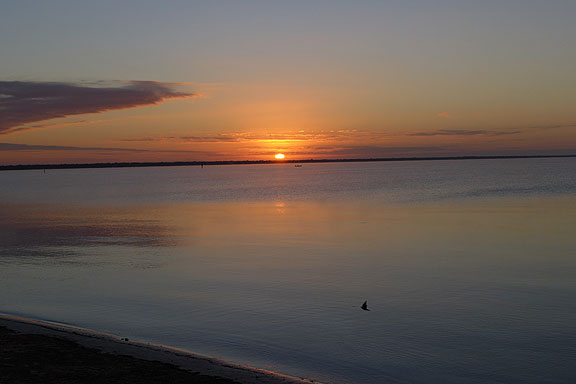
Sun rises over the Bay of Pigs












Leave a Reply